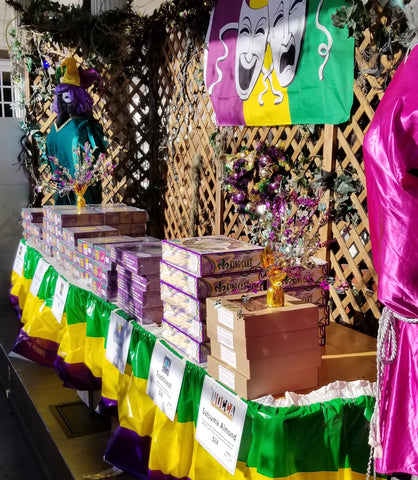
“So, what’s a king cake, anyway?”
We get that question a lot from tourists who find themselves in a veritable hub of king cakes and are bewildered by the offerings and varieties presented to them. So to help clear things up, we’ve come up with this essential history of this Carnival staple.
On January 6, 1870, the first king cakes made their way to New Orleans by the French who showed up at our virtual doorstep bearing the tasty treat. The conversation, we believe, went something like this:
“Bonjour, Nouvelle Orleans! We come from France, and we have a tasty treat for you!”
Back in the day, there was not the plethora of king cake options available to the masses today. There was no decision you had to make between filled and unfilled, sweet and savory, icing or color-sugared, cinnamon or no cinnamon, Keto-approved versus paleo-friendly, or vegan versus pesca-pescatarian (one who eats solely fish that eat other fish). Let’s go to the clip:
But we digress. When the king cake arrived from France, it was a rounded puffed pastry filled with frangipane (almond cream). (“Excuse me, Mr. French person, but we have a nut allergy.”) The cake was known as the Galette Des Rois, which loosely translates to “Galette of Da’ Kings.” There are actually three different styles of cakes that make up the Galette des Rois, the one with which we are most familiar is known as the “northern cake.” The other two cakes, more common in the Southwest region of France, are a round brioche sprinkled with granulated sugar and one found with candied fruits.

By that point, the French had had some experience with cakes- the Galette des Rois tradition dates back to the 13th century. On the Epiphany, the twelfth day following Christmas, families would bake a cake to share among family members and servants. Everyone would get an equal-sized slice, but the first slice would be reserved for the first pauper who would knock at the door. This was known as the “Part du Bon-Dieu” or “Part du Pauvre” (translated to Good Lord’s slice or Poor man’s slice). As the tradition evolved, the first slice became reserved for a family member who may have been absent so it was good luck to keep the slice fresh to encourage the family member’s safe return.
Eventually so as to add to the health and choking hazards of the baked goods, bakers began to bake small treasures inside the cakes, such as a bean or a gold or porcelain charm (the French called them fèves, because those French have a different word for everything). The one who finds the treasure inside their slice (provided they don’t choke and die) is chosen as King (or Queen) for a Day. Nowadays, of course, it is customary for the one who finds the baby inside their slice to buy the next king cake. We at King Cake Hub support this custom. We also support public shaming of those who do not honor this tradition (such as that one guy in the office who very skillfully avoids taking that piece of the king cake that has the baby even if it means leaving a minuscule piece of cake that in no way can be considered a “serving” for someone else. He or she should be shunned).

The modern New Orleans king cake shares more similarities with the Spanish or Latin version, the Rosca de Reyes (Ring of ‘Da Kings). This oval-shaped cake is decorated with figs, cherries or other dried and candied fruit. In some places the Roscón (Roscon is the singular of Rosca, unless it isn’t) is baked with trinkets. This tradition of having a treat baked inside the cake can be traced back to the ancient Pagan festival of Saturnalia which, along with the festival of Lupercalia, forms the framework on which Carnival is commonly known (Okay, Lupercalia was a fertility festival with animal sacrifices, random sexually-charged coupling, and no doubt wanton glances so we’ll just leave that right there). Saturnalia was celebrated in December and featured role-switching among the hierarchical classes through a fava bean hidden inside a cake. The one who found this “magical” bean was chosen as King for the Day. Usually a lower member of the household, this mock king was known as the “Lord of Misrule” and he was responsible for making mischief and ruling over chaos.
In the last 150 years, king cakes have evolved into a wide variety of baked treats with creative fillings, toppings, and décor. King Cake Hub is proud to offer over 50 varieties of the best from around New Orleans and Southeast Louisiana and we continue to be amazed by the talent and creativity our bakery partners use in experimenting with new flavors and techniques while honoring the culture and traditions of Carnival. From the classic cakes reminiscent of Old-World Europe to the newest creations by our talented bakers, you’ll taste the Carnival spirit at King Cake Hub!
Read More About it!
To learn more about King Cake History, visit your local library or just stay pantsless and click on the following:
https://mardigrastraditions.com/king-cake-history/
https://www.frenchasyoulikeit.com/galette-des-rois-a-sweet-french-tradition/
https://www.gourmetgirlsonfire.com/epiphany-and-the-galette-des-rois/
https://www.travelfranceonline.com/galette-des-rois-kingcake-origin-and-recipe/
https://www.pastemagazine.com/articles/2016/02/a-short-history-of-king-cakes-long-history.html
https://southweststory.com/wxfebp/galettes-des-rois
https://www.bestday.com/Editorial/Rosca-de-Reyes/
https://en.wikipedia.org/wiki/Rosca_de_reyes
https://www.eater.com/2017/1/11/14168802/king-cake-history
https://www.history.com/topics/ancient-rome/lupercalia
https://www.kingcakeshop.com/tasty-info/the-history-of-king-cake/

